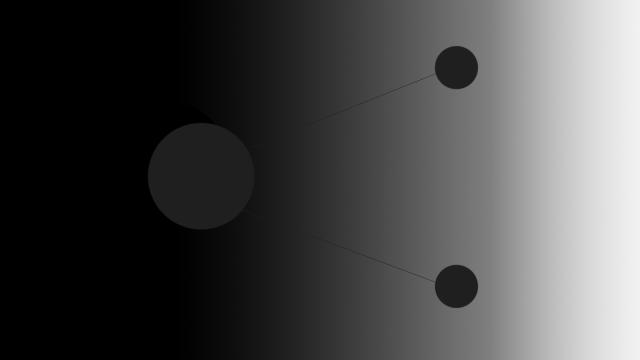It appears that the universe is full of dark matter – around six times more of it than there is regular matter. It has obvious visible effects, such as the way it bends light from distant galaxies. Despite dedicated searches, no signs of a dark matter particle explaining these effects have turned up.
Image: Ryan F. Mandelbaum
Perhaps instead physicists will be able to find some dark force, a portal into the dark world. Such a “dark photon” would be dark matter’s equivalent of a photon, in the way that dark matter particles interact with one another. Scientists are searching for such a particle. It hasn’t turned up yet, based on new results from the Large Hadron Collider in Geneva Switzerland. But the search isn’t over – and a lot of physicists are really excited about it.
“LHCb had to work really hard to get to this mass range,” Caterina Doglioni, a researcher at Lund University who was not involved in the study, told Gizmodo. “The way they did it is quite cool. They reinvented the data taking of LHC experiments.”
Physicists have been using plenty of methods such as big vats of liquid xenon to try and find dark matter particles directly, and still have no leads. Dark photons would take Dark Matter’s story deeper, and imply that there’s a dark universe governed by dark forces.
“What we now about dark matter is very little. One of the pressing questions is, how does dark matter interact with itself? That’s a wide open space,” study author Mike Williams told Gizmodo. He said that discovering this particle could open up an entirely new area of study.
Actually looking for this particle is a chore. Williams hoped that the LHC’s high-energy proton collisions would result in dark photons that then decay into other particles called the muon and its antiparticle partner. But there are a ton of less-ghostly ways that particles in the searched-through mass range could decay into two muons. In some cases, hunting for it is like trying to find out whether someone dumped a bag of M&Ms into a vat of M&Ms at the lolly factory by comparing the contents of the vat to the factory’s usual output.
Doglioni was especially impressed by how the team managed to get all their data. Particle physics experiments create so much data that they have triggers – initial detectors simply tell the experiment to keep all of the data in the collision or throw it all away, based on predetermined parameters. LHCb updated their data-taking scheme to allow the triggers to select only the data in the collisions they want, the two muons, for any events that contain them, rather than throwing away entire events that might have useful information.
After analysing data, they couldn’t find dark photons with masses between 10GeV and 70GeV that immediately decay into the muon pair (a Higgs Boson weighs around 125GeV). They also didn’t find a signal for longer-lived particles that weigh between 214 and 350 MeV (a proton weighs a little less than 1000 MeV), the first such search for these longer-lived dark photons. They published their results in Physical Review Letters.
But people aren’t upset just yet. “I am specially excited with their results for ‘long-lived dark photon’ region, where the dark photon travels a finite distance in the detector before decaying,” Suchita Kulkarni from the Institute of High Energy Physics in Austria told Gizmodo. “This constraint is really awesome! This region being searched for by LHCb… is really a sweet-spot accessible to very few experiments at this moment.” Essentially, LHCb is looking for a kind of particle that other experiments might not be able to find. She also pointed out that more complicated photon models might require another look at this data.
CERN Physicist James Beacham from the ATLAS experiment was also excited by the result, and hoped it would motivate competing ATLAS and CMS teams to finish similar analyses, too. And this dark photon search, which has already been going on for a long time, will probably continue. “Dark photon searches are simultaneously straightforward and challenging, straightforward because the concept is general and simple enough that designing experimental searches is pretty easy, but challenging because we really have no clue where in parameter space the dark photon could live,” he said.
Given all of the unknowns, physicists really need a sign. Williams said: “Any hook in would really help guide us to what to do next.”
[PRL]
